Sameer Badarudeen, Robert M. Bernstein and Saul M. Bernstein • Figure 1 is a radiograph showing fracture of the neck of the radius that could be treated with closed reduction or percutaneous reduction. • Figures 2 and 3 are radiographs of a fracture of the neck of the radius with complete dislocation that may be difficult to reduce closed.
Radial Head/Neck Fracture
Closed Reduction, Percutaneous Reduction, and Open Reduction
Indications
 Depending upon the extend of fracture displacement and angulation, there might be better indications for each of the three different techniques: closed reduction, percutaneous reduction, and open reduction.
Depending upon the extend of fracture displacement and angulation, there might be better indications for each of the three different techniques: closed reduction, percutaneous reduction, and open reduction.
 Closed reduction indications: Fractures with displacement greater than 2 mm or lateral angulation greater than 20–30°.
Closed reduction indications: Fractures with displacement greater than 2 mm or lateral angulation greater than 20–30°.
 Percutaneous reduction indications: Fractures with displacement greater than 2 mm or fractures with lateral angulation greater than 20–30° that are not reducible by closed method.
Percutaneous reduction indications: Fractures with displacement greater than 2 mm or fractures with lateral angulation greater than 20–30° that are not reducible by closed method.
 Open reduction indications: Fractures with displacement greater than 2 mm or fractures with lateral angulation greater than 20–30° that are not reducible by closed or percutaneous methods. Also, reversal of the radial head (180° rotation) is an indication for open reduction.
Open reduction indications: Fractures with displacement greater than 2 mm or fractures with lateral angulation greater than 20–30° that are not reducible by closed or percutaneous methods. Also, reversal of the radial head (180° rotation) is an indication for open reduction.
Examination/Imaging
 Neurovascular examination (posterior interosseous nerve)
Neurovascular examination (posterior interosseous nerve)
 Orthogonal radiographs of the radial head and elbow joint
Orthogonal radiographs of the radial head and elbow joint
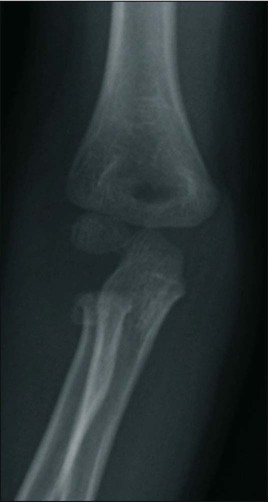
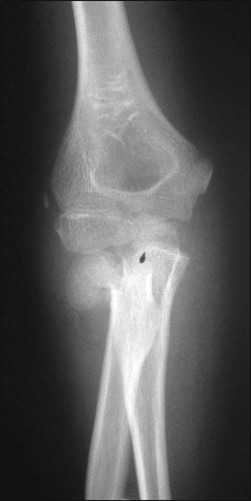
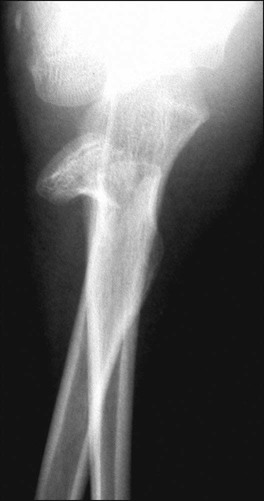
 Arthrogram in children in whom the radial head secondary center has not yet ossified
Arthrogram in children in whom the radial head secondary center has not yet ossified
Surgical Anatomy
 The radial head and neck are subcutaneous on the lateral side of the elbow, just distal to the lateral epicondyle.
The radial head and neck are subcutaneous on the lateral side of the elbow, just distal to the lateral epicondyle.
 The posterior interosseous nerve penetrates the supinator muscle just distal to the radial neck and may lie directly upon the bone (Fig. 4).
The posterior interosseous nerve penetrates the supinator muscle just distal to the radial neck and may lie directly upon the bone (Fig. 4).
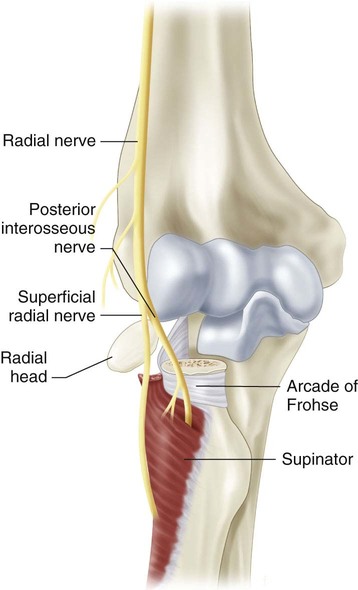
 Figure 5 depicts the surface anatomy of the posterior interosseous nerve in relation to the radial neck.
Figure 5 depicts the surface anatomy of the posterior interosseous nerve in relation to the radial neck.
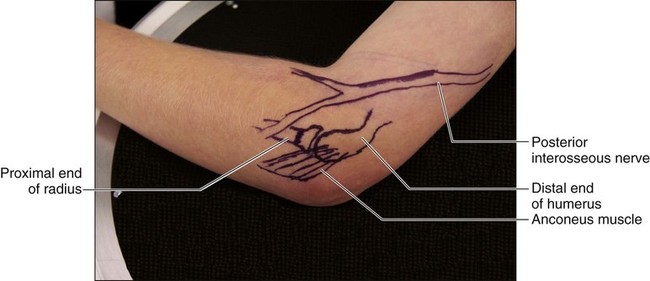
Closed Reduction
Positioning
 The patient is placed in the supine position on the table with the armboard at the ipsilateral head, folded in, to act as a headboard extension.
The patient is placed in the supine position on the table with the armboard at the ipsilateral head, folded in, to act as a headboard extension.
 The elbow is positioned over the fluoroscopic receiver (C-arm) (Fig. 6).
The elbow is positioned over the fluoroscopic receiver (C-arm) (Fig. 6).
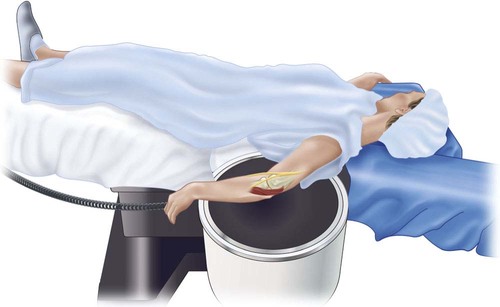
 The surgical assistant should stand at the ipsilateral head of the table, stabilizing the distal humerus.
The surgical assistant should stand at the ipsilateral head of the table, stabilizing the distal humerus.
 Figure 7 depicts the authors’ preferred set up of the operating room for a “left” radial neck fracture, with the armboard and C-arm on the same side and the monitor on the opposite side of the table.
Figure 7 depicts the authors’ preferred set up of the operating room for a “left” radial neck fracture, with the armboard and C-arm on the same side and the monitor on the opposite side of the table.
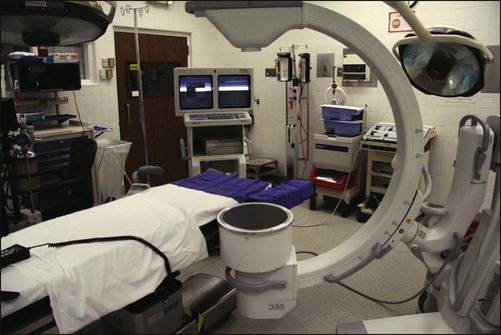
5: Radial Head/Neck Fracture: Closed Reduction, Percutaneous Reduction, and Open Reduction






